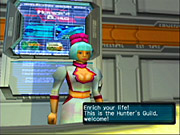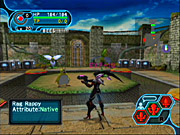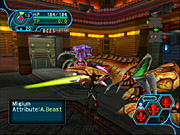Originally released for the Dreamcast, Sonic Team's Phantasy Star Online is already significant in the annals of video game history as the first online role-playing game for a console. Though it's now also the first online game for the GameCube, Phantasy Star Online Episode I & II doesn't quite have the distinction of the original. Indeed, those who extensively played the original probably won't think as highly of the game, especially since there's no keyboard available for the GameCube yet (the lack of which makes communication difficult), and there is a monthly subscription fee involved in playing the game online. Furthermore, the game's offline mode still lacks a competitive element and an engaging storyline, making it a weak alternative to the online component. But, those playing Phantasy Star Online for the first time should be able to overlook these drawbacks and delve into an addicting and almost never-ending 3D dungeon crawl.

You'll find the same character-creation process in both the online and offline modes. Phantasy Star Online Episode I & II offers the same three character classes as the original game: hunter, ranger, and force. There's also an additional character type for each class that features slightly different attributes from other characters in that class. For example, most characters in the hunter class are proficient with swords and can use other weapons, including some of the less-accurate long-range weapons, and some can also use magic. The new female android hunter introduced in Episode I & II, however, can't use magic at all, but because of her metallic body, she's immune to poison attacks, whereas other hunters are not.
There are similar advantages and disadvantages to using characters in the other classes, as well. The rangers use guns as their primary weapons and can use all the rifles and other specialized long-range weapons in the game, but they have only a limited ability to use melee weapons. In the original game, only one character in the ranger class had magic capabilities, but in Episode I & II there's another character that can use a variety of offensive spells to offset her inherently weak strength. The force class is made up of magic users that can't use some of the stronger weapons and that are generally weaker than any other characters. The new character added to the force class is for hard-core magic users and is incredibly difficult to use in the early levels simply because of his low defensive capabilities. It's also worth noting that new players should level their characters up in Episode I before attempting to take on Episode II, because of its higher difficulty.
The characters in Phantasy Star Online Episode I & II are pretty well balanced, which encourages you to have a healthy mix of classes in your online party or in the offline split-screen multiplayer mode--at least during boss battles and in the later stages of the game. In the earlier levels, you'll notice that the long-range-weapon users (the hunters and rangers in particular) have an advantage over melee characters simply because enemies can't walk through entryways. This allows for the strategy of walking into a room, firing a few shots at an enemy, walking back outside the room, and then repeating the process until all of the enemies in the room are dead. If you're a melee character, fighting in close quarters puts you at risk of being counterattacked by an enemy and then being trapped by a group of foes. When that happens, you better hope someone in your party has the ability to resurrect your character, or you're going to head back to the Pioneer--the equivalent of a home base, where you can buy weapons, armor, or items. You don't lose any of these items when you die, though you do lose money. You can also use the Pioneer as a safe area to feed your mag. A mag is somewhat like a virtual pet, which gives you bonuses to different attributes. They can become stronger and change in physical appearance after being fed certain types of items, which will determine what sort of special attack the mags can unleash when their energy meters are full.

Those just learning to use Phantasy Star Online's combat system may be seeing the Pioneer quite often, because there's a small learning curve for using the system effectively. Regular weapons have two attacks--regular and strong--while unique weapons have both of these attacks as well as a special attack. To launch a combination of any three attacks, you have to properly time them, which can be a little difficult initially, and it can be made even more complicated by the game's relatively poor targeting system. Instead of letting you manually lock onto an enemy, the game automatically decides what to lock onto, which is usually the object within your direct line of sight, whether it's a treasure box or an enemy. As you might suspect, this becomes problematic when engaging a group because the game won't necessarily target the nearest enemy, thus allowing it to slip by and attack. In addition, you'll occasionally find yourself struggling with the camera to adjust your line of sight so that you can target a specific enemy.
Thankfully, if you're playing the game online, you can always call for help if you're in trouble. Though the lack of a keyboard certainly hurts the experience, Phantasy Star Online Episode I & II retains the symbol chat and macros setting from the original game, so you can quickly tell your teammates that you're in trouble with a specific symbol or with preset text that you can enter with the press of a few buttons. You can also communicate with others outside of your game via guild cards, a service that lets you send e-mail to other players in the game to let them know you're online or let them know which server to play on. However, none of these features particularly help the problem of trade, something that requires quite a bit of talking. There's an option to engage in a trade via a trade window where you and other players can verify items before going through with the deal, but it doesn't leave much room for negotiation other than repeatedly sending a request to trade but with more items involved. In the split-screen modes this isn't an issue since your teammates are sitting next to you, but the split-screen option has a series of problems that make it much less enjoyable than the online experience.
Phantasy Star Online Episode I & II supports up to four players via a split screen, but it's not quite the same as playing the game online. Perhaps the most noticeable difference between the two options is death. In split-screen mode, when one character dies, it can either stay dead and let the other characters in the game continue or it can go back to the Pioneer, but if the character does go back to the Pioneer, then all of the other characters automatically go back as well, since Sonic Team apparently couldn't find a way to render completely different environments within each split-screen window.The camera also seems to become worse in the split-screen mode. For example, during one of the boss battles, the camera is always panned upward, not allowing you to see any items or hazards that might be on the ground. You'll also struggle with the camera while maneuvering through tight corridors, though in some cases you can move the camera out of a bad area.

The single-player campaign doesn't have such problems, but it's also much less entertaining than the online or split-screen options. When playing online there's more of a competitive element, with players competing to get the best weapons, armor, unique symbol chat picture, cool mag, or simply the best character. It's fun to interact with other players. In the single-player game, you don't get any sense of interaction, and the storyline is so weak that it might as well not even exist.
You can also participate in some of the alternative modes, such as challenge and battle, in the single-player game. The challenge mode gives participants random statistics and weapons and then places them in a level from the game where they have to struggle to stay alive as long as possible. The battle mode is essentially the same as the regular multiplayer mode, but it lets players attack each other, so it can essentially be used as a means for dueling. Interestingly, the dueling win and loss record can be displayed over a character's head while walking through the lobby, so you can see what kind of opponent you're going up against.
The online mode seems to be pretty stable at this point, with only a few slight syncing problems, such as characters not appearing in the proper area, and there are already quite a few players online, so you shouldn't have trouble finding a game whether it's Episode I or Episode II. The online mode requires you to purchase either a GameCube broadband or modem adaptor, which are pretty easy to set up, and it also requires you to pay a monthly subscription fee of $8.95.
Phantasy Star Online's visuals probably won't be enough to entice anyone to overlook the subscription fee, especially considering that the Episode I levels look nearly identical to their Dreamcast counterparts, except for a few slight enhancements to special effects. The first two environments in Episode II aren't all that detailed, and when you see the later levels, you'll be wondering if you're playing the same game. Instead of being simplistic rectangular environments, the later levels in Episode II are much more free-flowing and natural, with an enormous amount of detail and plenty of spectacular visual effects, including some incredible-looking water and lighting. The jungle level in particular has a few visually spectacular moments, but one in particular shows a series of pools of water on top of a cliff overlooking the ocean. The frame rate remains fairly constant throughout most of the game, but it tends to take a nosedive during some of the multiplayer boss battles, such as the Episode II dragon fight. This can make it difficult to play the game, since targeting is based on movement.

Like in the original game, the music isn't particularly memorable, and in some cases it plays an ambient role. Interestingly, none of the tracks seem to become annoying, even though you have to listen to them repeatedly. Oddly enough, Sonic Team chose to use music from Sonic Adventure 2 in some of the side quests that you can sign up for while on the Pioneer, which is either a sign of sheer laziness or a sign of Sonic Team's adoration for that game's soundtrack, but in either case, it's a distinct departure from the rest of the music in the game. Those with good sound equipment will be happy to know that the game supports Dolby Pro Logic II.
It all boils down to this: If you've played the original Phantasy Star Online extensively on the Dreamcast, then there isn't any significant reason to play through the game on the GameCube--the new characters and environments aren't enough to warrant the subscription fee, and the split-screen mode can be incredibly frustrating. Also, the current lack of a GameCube keyboard in North America makes online communication a hassle. But if PSO Episode I & II is the first chance you have to experience the series, then that fee shouldn't be quite as intimidating, because, despite the game's flaws, it's still as addictive as ever, and you'll find yourself playing it for hours on end.